#miss universe cameroon
Explore tagged Tumblr posts
Photo





Miss Universe Cameroon 2022 National Costume
This costume was put together to celebrate the rich cultural diversity of Cameroon, known as Little Africa or *Africa in Miniature,* paying attention to the strength and role of the African woman in her society and the world at large! This costume also represents the Greatness of Cameroon through its landmarks and natural resources. *The crown* has *three Cameroon maps* in the colors of the *Cameroon Flag* ; *ĢREEN, RED, YELLOW.* The *green* represents hope and the lush forest of Cameroon, the *red* is the unity of the country and the *yellow* represents the sun, prosperity and the savannah. The *crown* portrays the flag sitting on the highest point of the country, *Mount Cameroon whose native name is *Mongo ma Ndemi* ("Mountain of Greatness"). It is the highest point in sub-Saharan western and central Africa and is 4095 meters high. The *Golden necklace* on her neck is inspired by the shape of the Cameroon Mountain. The *Cape* around her arms is inspired by the spiral form of the of *Cameroon's Reunification Monument* that was constructed in the 1970s to memorialize the post-colonial merging of British and French Cameroon. This monument is located in Yaounde, the capital of Cameroon. The *skirt* carries the *Kounga mask* , a symbol of culture in the West region of Cameroon. The *golden handcrafted bracelets and pieces* above the kounga mask are made of precious metals from Cameroon. The metal bracelets carry African symbols of Royalty.
#miss universe#miss universe cameroon#cameroon#miss universe 2022#national costume contest#national costume#pageant#YES#GIVE US ALL THE MEANING
245 notes
·
View notes
Text
The B in Black stands for Beautiful.
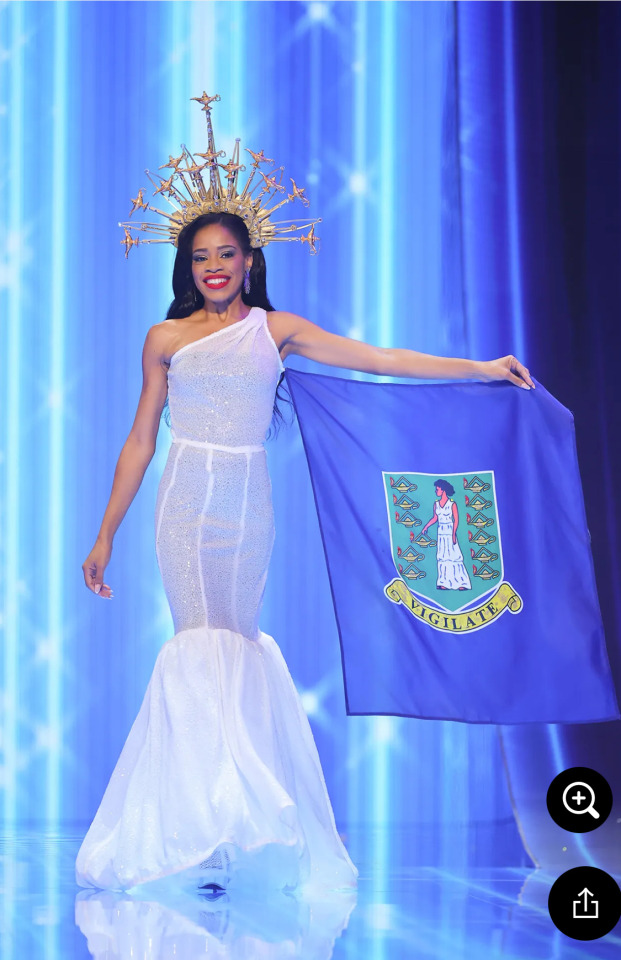



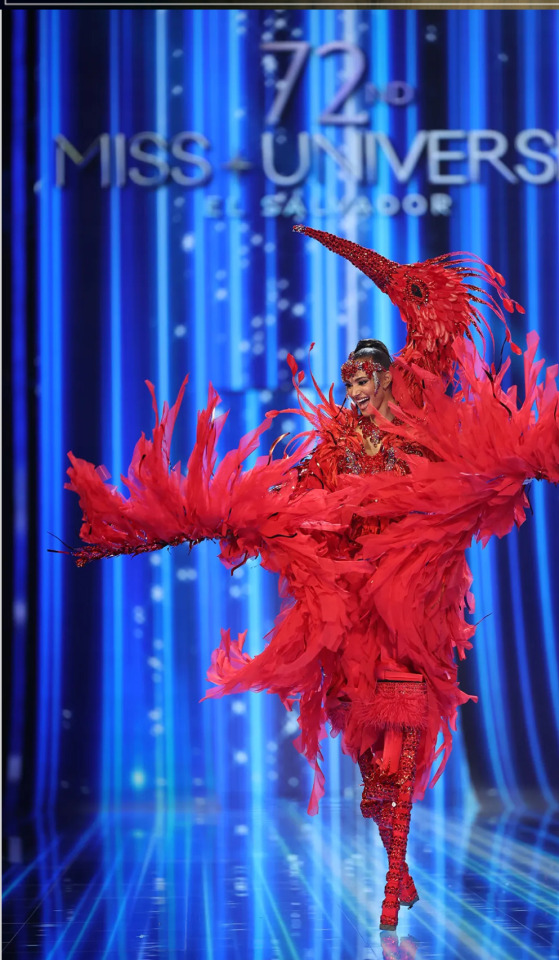

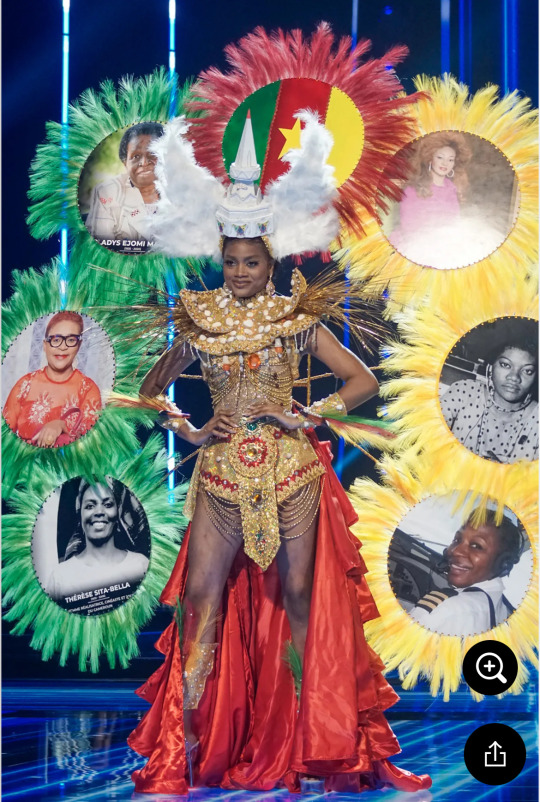

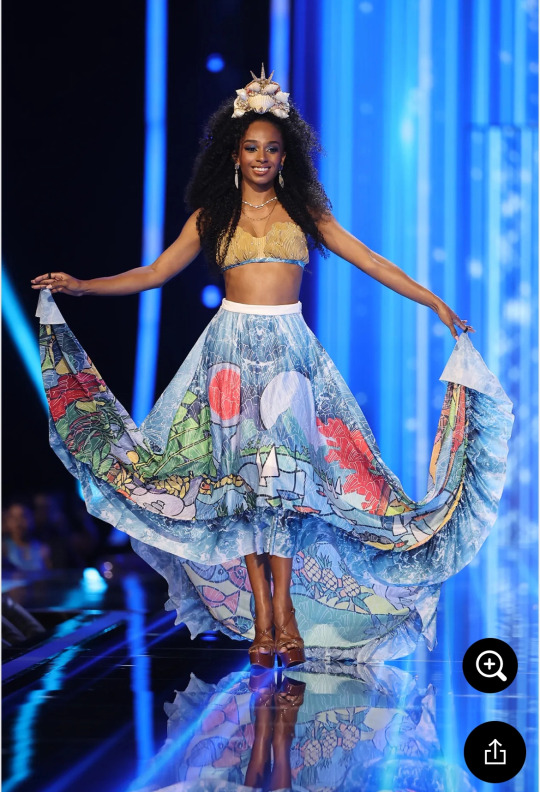
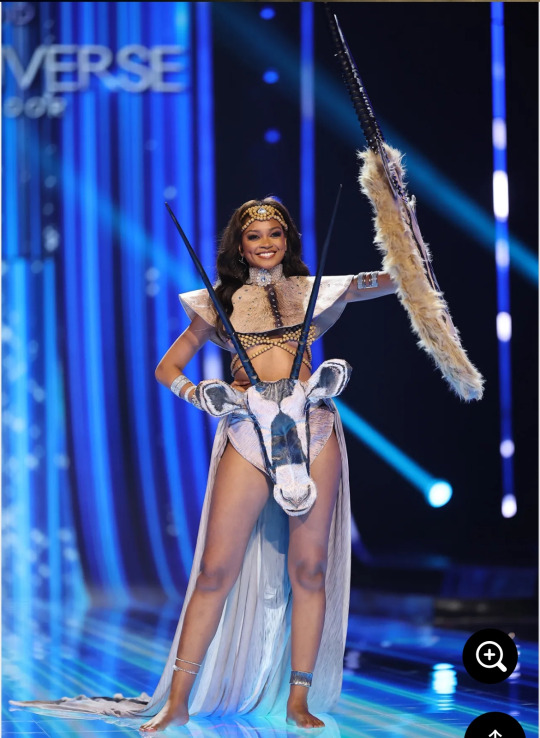
Article
#black beauty#black women#black women appreciation#miss universe#miss universe 2023#miss Ireland#cameroon#Angola#trinidad and tobago#Nigeria#Spain#guyana#british virgin islands
53 notes
·
View notes
Text
Noura Njikam biography: 15 things about Miss Universe Cameroon 2024
View this post on Instagram A post shared by Noura Njikam (@miss_universe_cameroon) Who is Noura Njikam? Noura Raïssa Noura is a Cameroonian beauty queen from Yaoundé, Centre Region, Cameroon. She will represent Cameroon in Miss Universe. Njikam is an alumna of Collège Bilingue Charles et Thérèse Mbakop and the Faculte de Sciences Juridiques et Politiques (FSJP) of the University of Yaoundé…
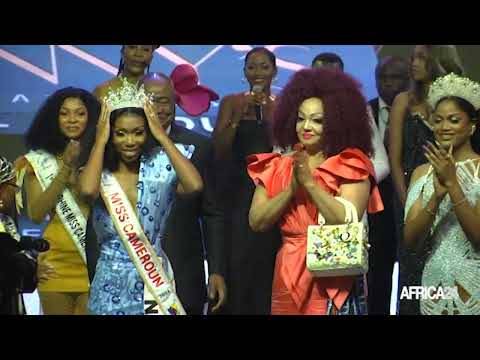
View On WordPress
0 notes
Text
instagram
0 notes
Text
The 2022 Miss Universe pageant was last night!
Which means: the National Costumes are here.
Yes, there is video. It’s worth watching if you want to see how some of these look in motion, but I’m warning you in advance that the emcees keep doing these shitty little rhyming couplets, and they will make you want to strangle them with one of the many available voluminous gown trains. So I’m suffering on your behalf, and liveblogging.
First up: Albania.

Sparkly flag-inspired bodysuit with train is the voting “present” of the Miss Universe National Costume Competition.
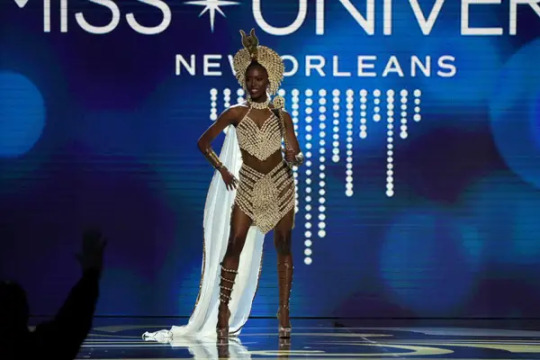
Angola. She did a fun dance on her way to center stage, which would probably not have been possible in her original costume, which was “tree-inspired” and too big to ship to New Orleans.

Argentina. This is where the video does come in handy, because without it I would not be able to award her First Contestant To Visibly Struggle Under The Weight Of Her Outfit. It’s a waterfall. The rainbow crotch area was certainly a design choice.
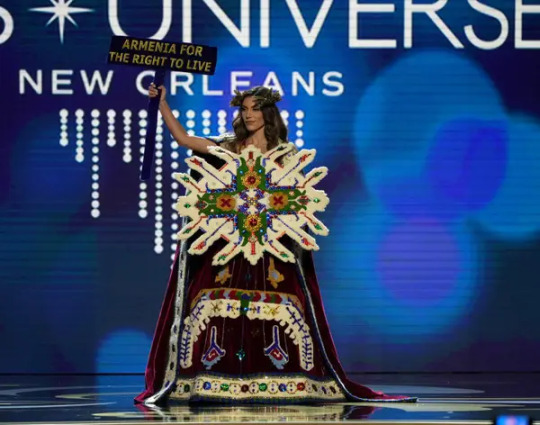
Armenia. I would like to see what’s going on with the bodice behind the... shield thing? but she never put it down.
Also, it turns out that when one contestant has a costume dedicated to solemn remembrance of the Armenian genocide, and the contestant immediately after her has a costume that’s about beach parties, there is kind of an uncomfortably abrupt tonal shift that happens onstage.
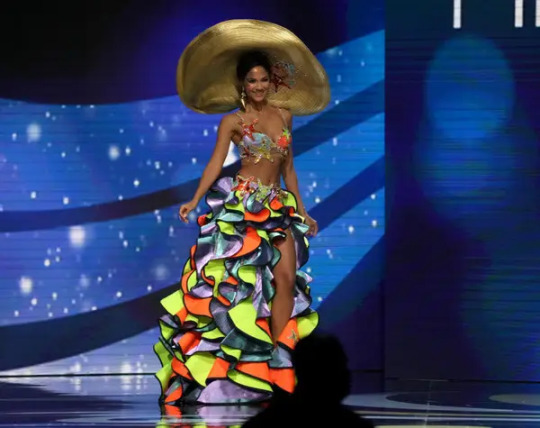
Aruba. Like I said: weird tonal shift! She did a little shimmy dance at Miss Armenia as they passed each other and it was clearly awkward for both of them. This is made of recycled materials leftover from Carnival, which is cool? I guess?

Australia. This is a prom dress. Boo.

Bahrain. A rare pants look! There’s a lot of detail in the headdress and bodice that’s kind of getting lost, but it looks cool in motion. Also the theme is apparently “Bahrain is rich as fuck,” so congrats I guess?

Belgium. Okay so the theme of this costume, my hand to g-d, is “the window on the International Space Station that Belgium built.” Why does this requires a shit-ton of leftover Christmas tinsel and some very awkward-to-wear angel wings? I do not know.

Belize. This is fun! It’s a good “lesser-known Batman villainess” kind of look. Like if Ivy and Catwoman co-mentored someone. The actual theme is “the world’s only jaguar reserve, which is in Belize,” but I think it’s also kind of implying that she might be a were-jaguar. Which, again, is fun!

Bhutan. This goes in the “just an actual regional/folk costume” category, which is also kind of like voting Present, but it looks like the fabrics are nice.
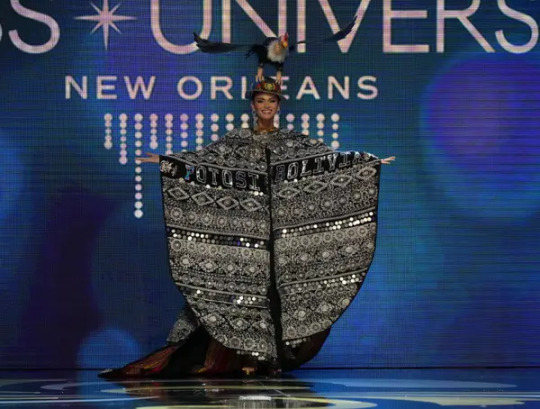
Bolivia. She has an entire Andean condor on her head so I’m already on board. This photo only shows the cloak, which is covered in silver spangles in honor of Bolivia’s silver mines, and is also why her condor is perched on a miner’s helmet. The dress underneath is entirely made of swags of sparkly gold beads, so the visual effect is actually pretty nice in motion.

Brazil. The construction details on this are actually quite lovely! Lots of intricate beading and rhinestone work. Unfortunately that doesn’t convey well at any distance, and also that white fin peplum thing flaps around really awkwardly when she walks. Oh, wait, she can flip it up to be a clamshell thing behind her head!
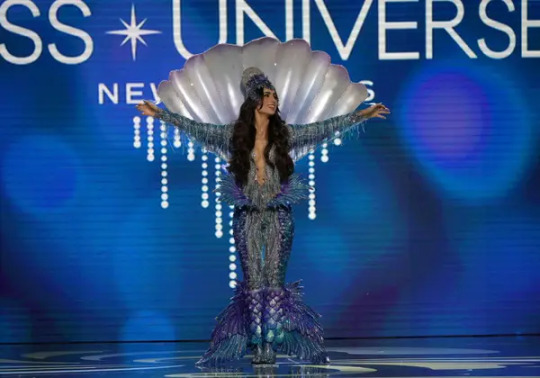
That looks much better.
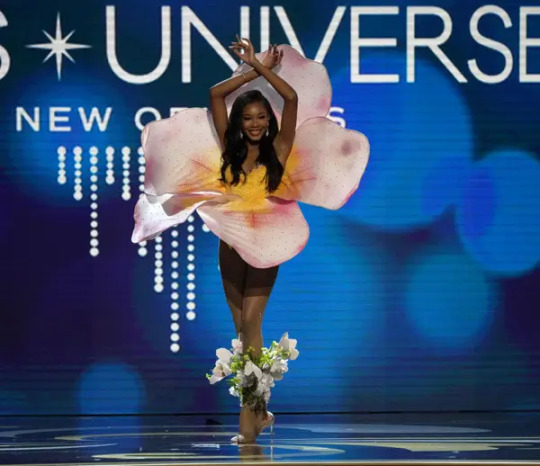
British Virgin Islands. First giant flower of the year!
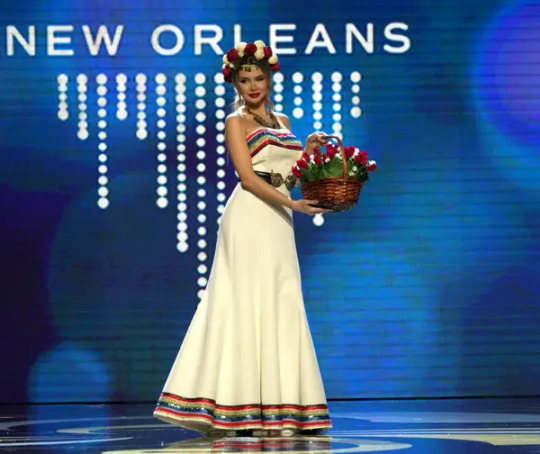
Bulgaria. Apparently this is made of neoprene? So with that and the rainbow stripes, the effect ends up being kind of “what if Midsommar, but at a rave.”
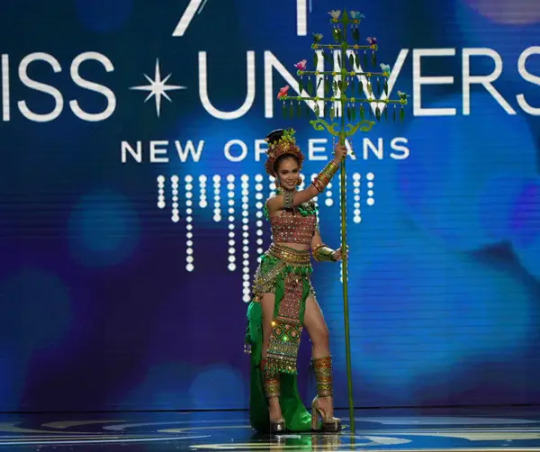
Cambodia. It feels weird to say “yep, standard Miss Universe warrior goddess costume” but basically that’s what this is. I do like the green-and-gold color palette, though.
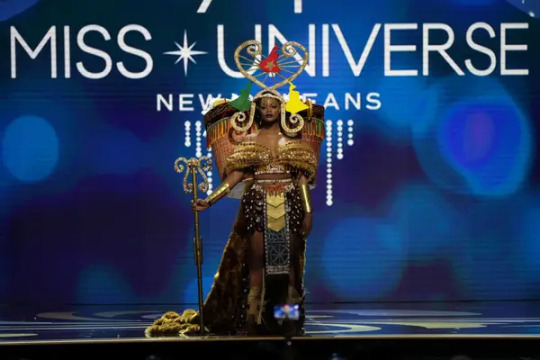
Cameroon. “The baskets represent the nation’s agricultural movement.” Okay! I like how it’s giving “Valkyrie, but make it Global South,” though I’m not sure three entire country-shaped cutouts were necessary.
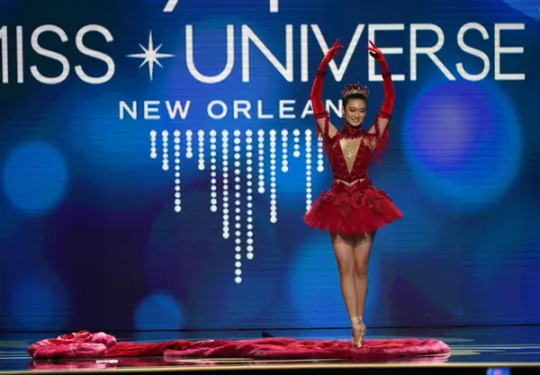
Canada. Another fine Miss Universe tradition: contestant who knows how to dance en pointe so she’s going to goddamn wear a costume that goes with pointe shoes, Or Else. Some nice beadwork! I would let her be the third, secret red swan in Swan Lake if that were a thing.

Cayman Islands. Sexy Blue Iguana is a fun concept! There’s a tail in back of the cape.
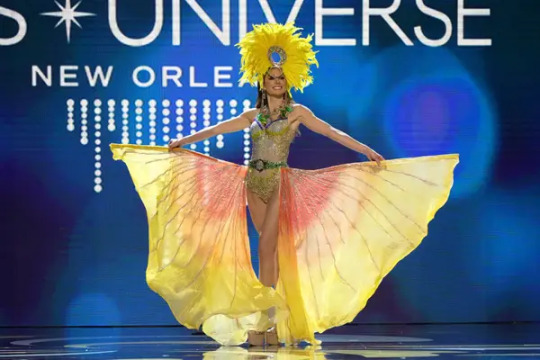
Chile. Sexy Atacama Desert is kind of abstract, as these things go, but I respect her choice to wear something she could walk in.

China. Hilariously, the announcer was like “This look... does not match the bio we were given, so I’m gonna wing it!” The fabrics are nice -- the satin drapes and moves well -- but the embellishments are kind of meh compared to some of the Miss China looks I’ve seen.

Colombia. This is a legit great Sexy Phoenix, but I need you all to know that her crown got turned a little sideways while she walked to the stage and she clearly knew it and just as clearly could do nothing about it, and I feel bad for laughing but it was funny.

Costa Rica. Sexy hummingbird! I think I’ve identified a recurring theme for this year. Corset and wings are made of recycled materials, which is nice, and they look well-made -- a lot of wing-based costumes tend to flop around or go crooked in motion, but not these.

Croatia. Oh, honey. This has big “my mom helped me make this the night before it was due” energy, unfortunately.

Curacao. “Meet the Fisherman’s Wife, a woman with a key role in Curacao’s fishing industry.” Okay? Honestly you could have left off the basket and said “this costume represents the beautiful marine life of Curacao” and I would have been like “yep, checks out” but now I have many follow-up questions.
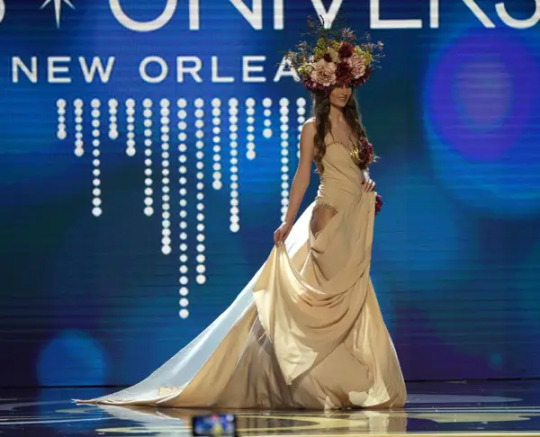
Czech Republic. This is meant to be a Mucha-inspired look but uh. Mostly it’s just. beige. I’m starting to feel like all the other Slavic countries saw advance photos of Miss Ukraine and were like “let’s just phone it in this year, girls, there’s no point.”

Dominican Republic. “This costume recognizes the importance of birds in Dominican culture.” They did make it with silk feathers, which I appreciate, because it would have been very weird to use real ones with that mission statement. Also I like her headdress, and the giant feather fans are a good way to nod in the direction of wings without the hassle of actually wearing wings.

Ecuador. This looks good in motion! She did some dancing onstage that worked well, and there’s a great sculpted Inca head scowling on the back of her headdress. This is still only a few notches above voting Present, though.

El Salvador. “History of Currency,” which is definitely a concept! The Bitcoin wizard staff is sure something.
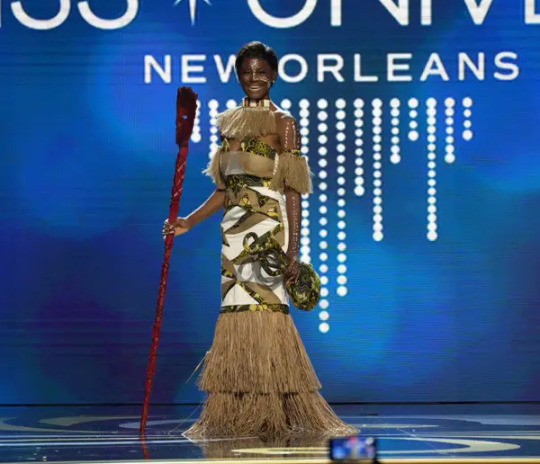
Equatorial Guinea. A perfectly nice entry in the “actual regional costume” category, but on the video I was like “oh, yikes, her headdress is really wobbly” and then it FELL OFF and I felt so bad for her.

Finland. “Spirit of the Forest”? Fuck off, that’s a prom dress. Boo.
I’m going to pause here so this readmore doesn’t get completely out of control. Shit, there are 50 more of these? Well, I have only myself to blame.
2K notes
·
View notes
Text

Prediction time!
It's Miss Universe season again, so here I am, keeping up with the tradition I started during last year's edition of this prestigious pageant.
Please note that this list is only based on the preliminary swimsuit and evening gown competitions since we don't have access to the interviews.
I had a hard time with this list 'coz I kept on switching names. And that's because... this was quite a boring set of candidates. There were only a handful who really gave a performance that made me smile, and most of the others were pretty much on the same level.

South Africa • Nicaragua • Puerto Rico • Philippines • India
Here's the first five. I'm not saying they're my predicted Top 5, but after watching the preliminaries, I think these women all deserve to be called in the finals.
Puerto Rico and Nicaragua... they wore ordinary and usual gowns but they SLAYED—even during the swimsuit segment. Just look at how beautiful they are.
Philippines. No bias here. She has this edgy, elegant vibe about her that only she can project and it's so beautiful to witness. When everyone is trying to fit themselves into the mold of a Miss Universe winner, MMD just let her own authenticity shine.
India and South Africa. They didn't disappoint me, and knowing how these countries prepare their delegates and choose those who CAN ACTUALLY SPEAK, I would be shocked if they're not in the finals.

Colombia • Canada • Australia • Mexico • Lebanon
This next group also did really well, but not as spectacular as those I've chosen above 'coz the nit-picky side of me found something off about them.

El Salvador • Guatemala • Venezuela • Thailand • USA
These candidates didn't do anything wrong—two or three of them actually gave good performances. Unfortunately, gut feels somehow tell me there's a chance they may not make it through to the finals. Someone here may be this year's El Tocuyo Queen.

Brazil • Namibia • Cameroon • Pakistan • France
This is more of a wishlist rather than a prediction. There's something about these girls that made me smile when they walked on the stage. But... I have huge doubts about them being called into the Top 20.
• • • • •
Finally, other candidates that caught my attention were Spain, Italy, Egypt, Mauritius, Cambodia and Chile.
5 notes
·
View notes
Text
Pottery Workshop in St Petersburg for Children and Adults
If you're interested in learning pottery, you can try a pottery workshop in St. Petersburg. These classes are fun and can be a great way to get away for a few hours to relax.
Pottery workshop St. Petersburg
If you are interested in learning about ceramics, there is a Гончарная мастерская Спб that is open to children and adults. These workshops focus on building a connection between the maker and the consumer.
Belinda Glennon, an educator, teaches ceramics classes for both adults and children. She also coordinates public school field trips. She is a graduate of the University of Central Florida.
Suze Lindsay studied ceramics at the Penland School of Craft, and returned to work as an artist-in-residence at Penland. In addition to her clay work, she has developed a unique style of figurative sculpture by manipulating forms after they have been thrown.
Maria Dondero, born in Yaounde, Cameroon, took her first pottery class in Guanajuato, Mexico. Her aesthetics draw from the history of ceramics around the world. She studied slipware from Japan.
Sarah Chenoweth-Davis works with stoneware clay. Her pots are inspired by nature and function. She has exhibited widely and has been recognized with awards from the Minnesota State Arts Board, the National Endowment for the Arts, and the McKnight Foundation.
Kris Erickson has been working with clay for more than two decades. His vessels are made on the potter's wheel and are glazed in textured white glazes. He has taught workshops at many art centers.
Matt Repsher, who earned his MFA from Indiana University in 2003, was an instructor at Indiana University and Indiana University-Bloomington. After graduation, he was a resident artist at Pocosin Arts School of Fine Craft in Columbia, North Carolina.
Over 200 ideas for inspiration
For a budding potter or pottery enthusiast, there's a new hot spot in town to tote the family to and fro. The Factory is located in the Warehouse Arts District. Whether you're a novice or a seasoned pro, you're sure to find some zen time among the frenzies of like minded creative types. Not to mention the plethora of local restaurants and bars. You'll also find a slew of local makers, movers and shakers aplenty. And if you're lucky, you might even catch a show. With a myriad of options for dinning, shopping and dancing, you'll be in awe of the sheer number of entertainment choices. So, get out there and try some of them out for yourself! A few lucky souls might even be rewarded with a prize or two. If you're really into the creative life, you might be willing to make the move south. Depending on your budget, you could be in the neighborhood of Tampa Bay, or at least the bay side. Whatever you do, don't miss out on a creative experience you'll be proud of.
Events and pottery courses
This beautiful city has a vibrant art scene and a booming performing arts community. It is also home to some of the country's best beaches and state parks.
The city is known as "The Sunshine City" for its constant sunny weather and breathtaking beaches. In addition to the beach, it is also home to a number of museums. If you are looking for a creative outlet, consider taking pottery classes. Alternatively, you may wish to take a day trip to the Florida Botanical Garden. These gardens offer trail hikes and educational demonstrations.
For adults and kids of all ages, there is a plethora of opportunities for learning about and playing with clay. Practically Pikasso, for example, offers over 300 ceramic pieces for sale, along with several workshops.
You'll need to make an advanced reservation to guarantee your spot. But rest assured, you'll be rewarded with a fun, informative experience that will last a lifetime.
The same goes for the numerous events and classes offered at the nearby Belger Arts Center. They offer everything from lithography workshops to pottery classes, and more. Several of these classes are designed for adults and kids, allowing you to spend quality time together while making something special.
Likewise, the Belger Arts Center boasts a metal yard and exhibition space. They also offer monthly storage fees for your pottery creations.
2 notes
·
View notes
Text
Thanks for the help
Education Inequalities A massive amount of people on this globe do not have resources that allow them access to education, and a majority of them are children in unprivileged societies.
WHAT IS THE PROBLEM? Those living in north-eastern Africa are the least likely to receive a good education – or any education at all. It ranks the world's poorest countries according to their education systems. Somalia has the least functional system in the world with just 10% of children going to primary school, while Eritrea is second worst.
Haiti, Comoros and Ethiopia fare almost as badly. Before Haiti's earthquake this year, just 50% of children went to primary school. Now that figure is said to have fallen. Some 2.5 million children were left without a school to go to after the earthquake.
Here are 10 of the greatest challenges in global education:
A Lack of Funding for Education Money isn’t everything, but it is a key foundation for a successful education system.
Having No Teacher, or Having an Untrained Teacher We’re facing multiple challenges when it comes to teachers. Not only are there not enough teachers globally to achieve universal primary education (let alone secondary), but many of the teachers that are currently working are also untrained, leading to children failing to learn the basics, such as maths and language skills. Globally, the UN estimates that 69 million new teachers are required to achieve universal primary and secondary education by 2030. Meanwhile, in one out of three countries, less than three-quarters of teachers are trained to national standards.
No Classroom This seems like a pretty obvious one – if you don’t have a classroom, you don’t really have much of a chance of getting a decent education. But again, that’s a reality for millions of children worldwide. Children in many countries in Sub-Saharan Africa are often squeezed into overcrowded classrooms, classrooms that are falling apart, or are learning outside.
A Lack of Learning Materials Outdated and worn-out textbooks are often shared by six or more students in many parts of the world. In Tanzania, for example, only 3.5% of all grade 6 pupils had sole use of a reading textbook. In Cameroon, there are 11 primary school students for every reading textbook and 13 for every mathematics textbook in grade 2. Workbooks, exercise sheets, readers and other core materials to help students learn their lessons are in short supply. Teachers also need materials to help prepare their lessons, share with their students, and guide their lessons.
The Exclusion of Children with Disabilities Despite the fact that education is a universal human right, being denied access to school is common for the world’s 93 million children with disabilities. In some of the world’s poorest countries, up to 95% of children with disabilities are out of school. A combination of discrimination, lack of training in inclusive teaching methods among teachers, and a straightforward lack of disabled accessible schools leave this group uniquely vulnerable to being denied their right to education.
Being the ‘Wrong’ Gender gender is one of the biggest reasons why children are denied an education. Despite recent advances in girls’ education, a generation of young women has been left behind. Over 130 million young women around the world are not currently enrolled in school. At least one in five adolescent girls around the world is denied an education by the daily realities of poverty, conflict and discrimination.Poverty forces many families to choose which of their children to send to school. Girls often miss out due to belief that there’s less value in educating a girl than a boy. Instead, they are sent to work or made to stay at home to look after siblings and work on household chores.
Living in a Country in Conflict or at Risk of Conflict There are many casualties of any war, and education systems are often destroyed. While this may seem obvious, the impact of conflict cannot be overstated. In 2017, around 50 million children were living in countries affected by conflicts, with 27 million of them out of school, according to UNICEF. Conflict prevents governments from functioning, teachers and students often flee their homes, and continuity of learning is greatly disrupted. In total, 75 million children have had their education disrupted by conflict or crisis, including natural disasters that destroy schools and the environment around them.
Distance from Home to School For many children around the world, a walk to school of up to three hours in each direction is not uncommon. This is just too much for many children, particularly those children with a disability, those suffering from malnutrition or illness, or those who are required to work around the household. Imagine having to set off for school, hungry, at 5 a.m. every day, not to return until 7pm. Many children, especially girls, are also vulnerable to violence on their long and hazardous journeys to and from school.
Hunger and Poor nutrition The impact of hunger on education systems is gravely underreported. Being severely malnourished, to the point it impacts on brain development, can be the same as losing four grades of schooling. Around 171 million children in developing countries are stunted by hunger by the time they reach age 5. Stunting can affect a child’s cognitive abilities as well as their focus and concentration in school. As a result, stunted children are 19% less likely to be able to read by age eight. Conversely, good nutrition can be crucial preparation for good learning.
The Expense of Education In many developing countries, over the last decades governments have announced the abolition of school fees and as a result, seen impressive increases in the number of children going to school. But for many of the poorest families, school remains too expensive and children are forced to stay at home doing chores or work themselves.
WHAT CAN WE DO ABOUT THIS? Donations You can donate money to the charities that funds education.
Fill Teacher Gaps On current trends, some countries will not even be able to meet their primary school teacher needs by 2030. The challenge is even greater for other levels of education. Thus, countries need to activate policies that begin to address the vast shortfall.
At this primary school in the Eastern Cape, South Africa, there are 174 learners in one class. Many children don’t turn up to school because the learning conditions are so poor.
Attract the Best Candidates to Teaching It is important for all children to have teachers with at least a good secondary-level qualification. Therefore, governments should invest in improving access to quality secondary education to enlarge the pool of good teacher candidates. Policy-makers need to focus their attention on hiring and training teachers from under-represented groups, such as ethnic minorities.
Train Teachers to Meet the Needs of All Children All teachers need to receive training to enable them to meet the learning needs of all children. Before teachers enter the classroom, they should undergo good quality pre-service teacher education programmes and they need ongoing training so as to develop and strengthen their teaching skills and adapt to changes such as new curriculum. Teachers should be trained to teach multiple grades and ages in one classroom, in multi-lingual classrooms, and to understand how teachers’ attitudes to gender differences can affect learning outcomes.
Hadiza is a teacher in Maradi, Niger. “As soon as I got my secondary school certificate I started teaching. I was trained in 45 days and then started my career as a teacher. When I started teaching I quickly understood that the training I received was not sufficient for me to teach well. There are many challenges in teaching and I think without good capacities and some experience we are not able to handle the challenges.
Provide Better Data on Trained Teachers Countries should invest in collecting and analysing annual data on the number of trained teachers available throughout the country, including characteristics such as gender, ethnicity and disability, at all levels of education. These data should be complemented by information on the capacity of teacher education programmes, with an assessment of the competencies teachers are expected to acquire. Internationally agreed standards need to be established for teacher education programmes so that their comparability is ensured.
More and better data on teacher salaries in low and middle income countries are also needed to enable national governments and the international community to monitor how well teachers are paid and to raise global awareness of the need to pay them well.
The story is that 50 Cent kind of dropped a hint to me on wanting to help cure the Aids epidemic in Africa and I heard it and I proposed it to send the cure for aids in Africa to the people in Africa infected with HIV Aids and this is the news headlines in March 2023 of it going through another accomplishment on my list of accomplishment thank you so much and they should be continuing sending it to Africa daily every day week month and years for generations and generations from now on a continuous basis that would be the right thing to do true humanity .
Check the news on CNN The US helped prevent AIDS from being a death sentence in Africa . The us is me and 50 Cent the rapper from his hit show power .
We did it congratulations on the cure for Aids in Africa .
The US helped prevent AIDS from being a death Sentence in Africa
Check the news on CNN on ending HIV Aids in Africa with the cure and new medicine Cabenuva HIV medicine that cures HIV Aids like the common cold and any other kind of communicable diseases
We did it congratulations on the cure for Aids in Africa .
The US helped prevent AIDS from being a death Sentence in Africa .
Cabenuva the new HIV Medicine is the cure for HIV Aids it knocks out HIV Aids like the common cold please send it to Africa to help heal the people .
1 note
·
View note
Photo

📘 // Costumes from the 2022 Miss Universe Competition 1) Miss Guatemala Ivana Batchelor 2)Miss USA R'bonney Gabriel 3)Miss El Salvador Alexjandra Guajardo Sada 4)Miss Bahamas Angel J. Cartwright 5)Miss Trinidad and Tobago Tya Jane Ramey 6)Miss Ukraine Viktoriia Apanasenko 7)Miss Colombia Maria Fernanda Aristizabal 8)Miss Laos Payengxa Lor 9)Miss Cameroon Mouketey Lynette Monalisa Jelly 10)Miss Panama Solaris Barba 📸: Getty images (at New Orleans) https://www.instagram.com/p/Cnj6XOtA34n/?igshid=NGJjMDIxMWI=
0 notes
Text

Miss Universe Cameroon 2023 National Costume
49 notes
·
View notes
Text
Issie Princesse biography: 13 things about Miss Universe Cameroon 2023
Ndoun Issie Marie Princesse is a Cameroonian beauty queen. Here are 13 more things about her:
youtube
View On WordPress
0 notes
Text

Up next: Miss Cambodia! Who is wearing something vaguely historial and very gold. Love the level of detail but it's still voting Present a little bit.

Miss Cameroon is also in vaguely historical gold, but she has a sword so I automatically like it way better.

The first indigenous Miss Canada is wearing an absolute layer cake of a First Nations-inspired gown, and also I think there's a Northern Lights theme AND the gown lights up AND she has a sword. 11/10, no notes. She's struggling to walk in it but I don't even care

Miss Cayman Islands is wearing their national tree. Sure! This is fine.

Miss Chile is wearing the Sabado Gigante roulette wheel, and I love it when Miss Universe contestants push this competition one step closer to full-on drag, so this is great.

I literally can't look at this and say anything but the first words that come to mind, which are "boob dragons." I'm sorry, Miss China.

Miss Colombia is wearing the first of many costumes tonight that were perfectly fine until they decided to incorporate a mural painted by a seventh-grade art class. I genuinely don't understand why they keep doing this.

Miss Costa Rica is wearing the murals from a Depression-era city hall, which is better than the murals painted by middle schoolers but not by that much. Piling on additional indignities: the basket prop, sculptural flower hat, and the fact that she can barely walk in whatever shoes are under there.

More gold, for those keeping track. I love the idea of an elephant-themed costume, and Miss Cote D'Ivoire is having fun with those ears, but unfortunately someone missed the memo about not putting a major design element directly over the contestant's crotch.

Miss Croatia looks embarrassed, AND SHE SHOULD.

Miss Cuba is "a goddess of love and destiny, and protector of women and children" which, sure! It's big and gold and I like the materials they used.

Let's be real here, Miss Curaçao. You're wearing a sparkly evening dress with a giant flower tacked on to the back. This is low-effort and I expected better of you.
Fuck, I'm only ten minutes into the video. This might be a two-day liveblog, guys.
it's that time:
Miss Universe National Costume 2024
is Here!
that's right! Everyone's favorite justification for the continued existence of beauty pageants has returned. with Looks!
Some of this year's top Themes include:
foliage!
gold!
weapons!
giant birds!
letting seventh-graders make your costume, apparently!
I did watch the video, but the most complete version I could find is missing a bit at the beginning. So I can't tell you what the inspiration was for anything before Bolivia; on the bright side that's fewer shitty rhyming couplets I had to suffer through.
Let's begin with:
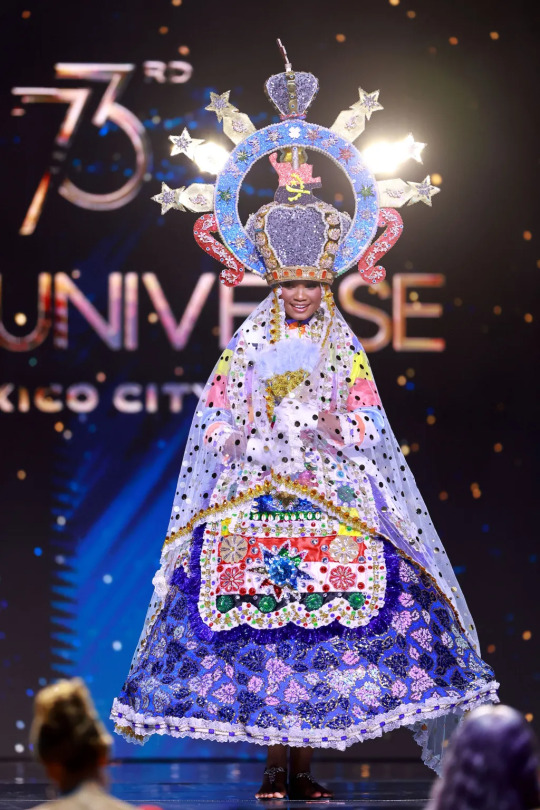
Miss Angola! Tone down the color palette a little, and this honestly could have worked for that year the Met Gala was Catholicism- themed.
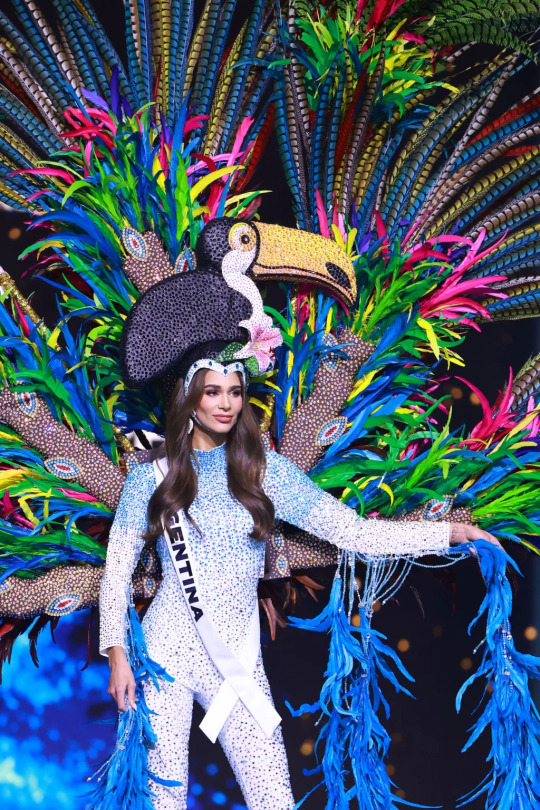
Miss Argentina, looking just thrilled about the sparkly toucan on her head. I feel like this is supposed to read as some combination of jungle/river/waterfall but this is from the part that I couldn't find on video.
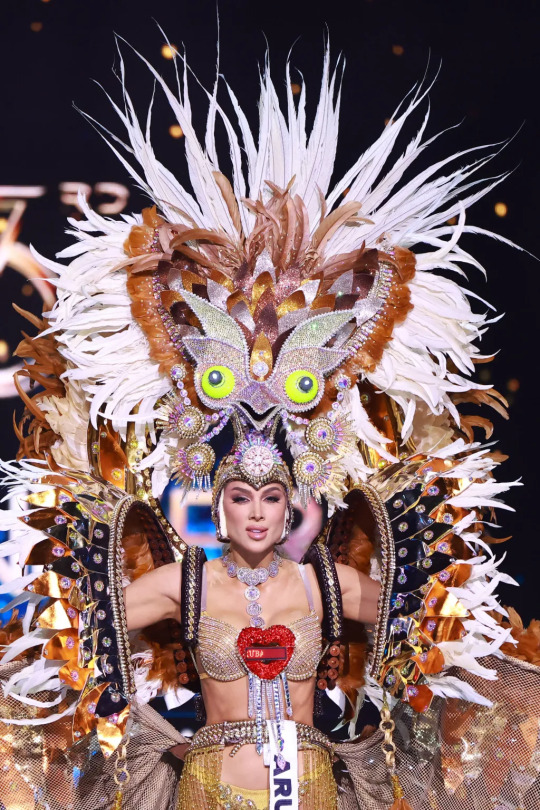
Miss Aruba, I don't know if your giant spangly bird headdress was supposed to look like a potoo, but I am choosing to believe that it's on purpose and I love that for you.
(okay I checked, it's an endangered Aruban burrowing owl. even better!)
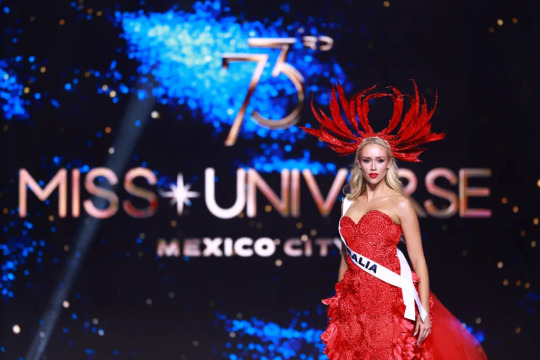
This is like the fourth year in a row Miss Australia has just worn a regular-ass gown. Do better!

You know who's doing better? Miss Bahamas, is who. Look at that giant fish. I wish I had video of this, I bet it moves.
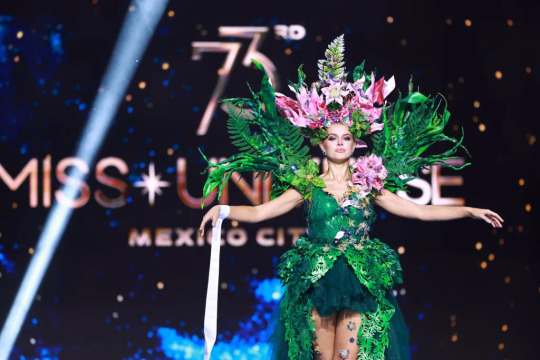
Ah yes, when I think of Belarus I definitely think 'verdant tropical foliage.' also is it just me or is does the bodice fit very weird.
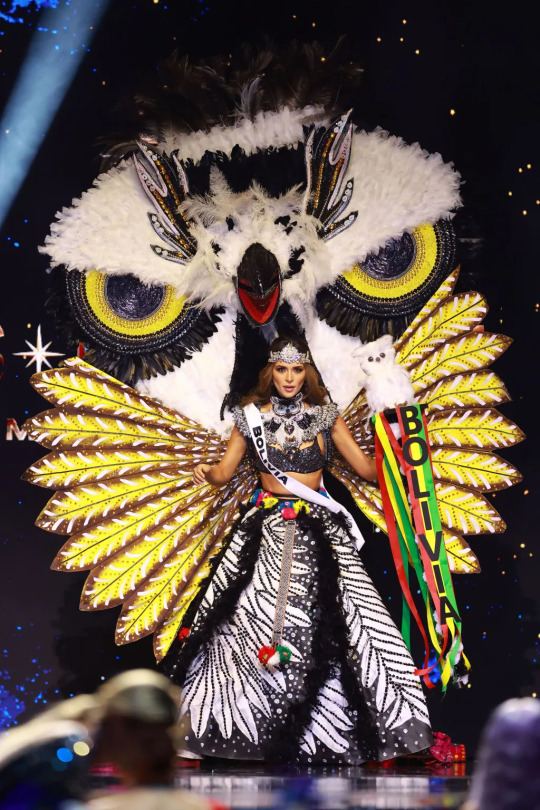
Holy shit, Miss Bolivia. This is where the video kicks in, so I can tell you that she somehow managed to dance in it. I'm a little afraid that this costume is going to eat Miss Aruba.

Miss Bonaire is from a Caribbean island that I don't think has ever competed in Miss Universe before? They have a national marine park that this costume is based on, which is is nice!

Miss Botswana's costume is made of leather and cowrie shells, and she is clearly having a great time being able to move freely without 75 pounds of headdress or platform heels. She did a very cute dance that kind of felt like a flex on her more heavily encumbered competitors.
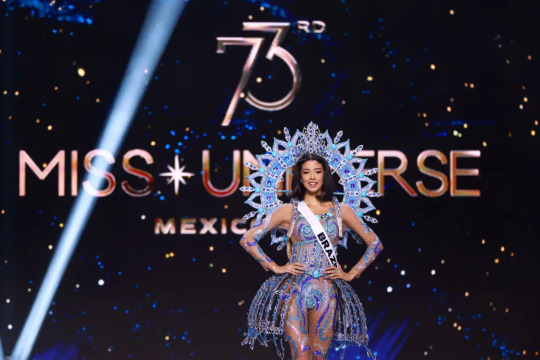
Miss Brazil is wearing a tribute to Brazil's mineral wealth, which is something that basically every country with a mine in it has done at some point. I like the pannier-esque things, I guess.
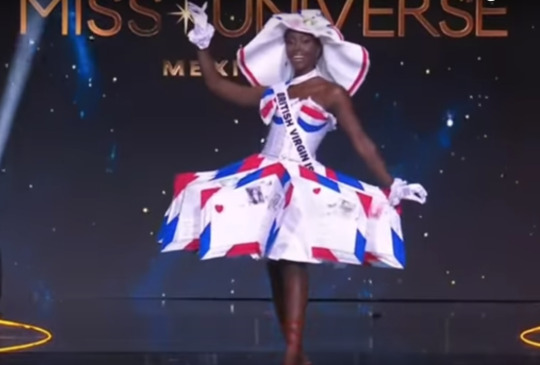
Love a Tribute To A Weirdly Specific Thing, and Miss British Virgin Islands' mail-themed costume is a wonderful example of such.
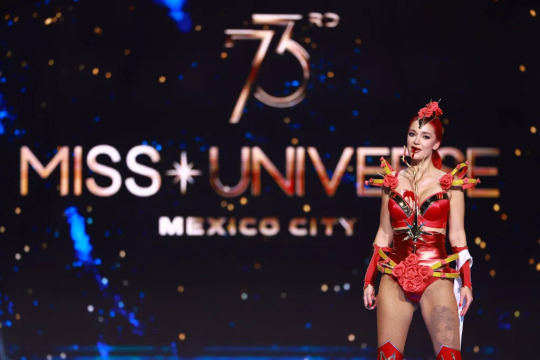
Miss Bulgaria showed up dressed as a supervillain, her outfit is vaguely themed around 'the strength of women' and she just spat out a MOUTHFUL of BLOOD? on stage??? No idea how to react to that, frankly.
I'm going to pause to get the next batch of images together, and also to recover from the 'spat out a mouthful of blood' thing, because I was NOT prepared for that.
3K notes
·
View notes
Text
Angele Kossinda: Cameroon’s bet for the 69th Miss Universe
Angele Kossinda: Cameroon’s bet for the 69th Miss Universe
Cameroon is one of only four African countries represented in the upcoming edition of Miss Universe. And Angèle Kossinda is hoping that she would be a clear standout in her continental grouping. You might be surprised to know that this Finance Master produces and acts in a TV comedy series available on YouTube. She has also traveled to ten different countries, including the Philippines. Miss…

View On WordPress
0 notes
Text
🎓 World Professors AU 🎓

Just thought it’d be fun to imagine what topics these characters would teach if they were university, college, or independent professors. And I made this AU to put off of doing chores....
🧮 Mathematics - Turkey 🚗 Engineering - Germany 🤖 Robotics - Japan 🛫 Aviation - America 💰 Banking - Switzerland 📈 Economics - Netherlands 🌱 Agribusiness - Ireland 🌁 Architecture - Hungary 👨🚀 Astronomy - Russia 🧭 Geography - Portugal 🐬 Marine Biology - Seychelles 🦋 Wildlife Conservation - New Zealand 🌋 Geology - Iceland 💊 Pharmacology - Canada 🐾 Veterinary Studies - Australia 🐘 Zoology - Thailand 🌾 Agriculture - Ukraine ⛵ Maritime Studies - England 🎨 Visual Arts - Italy & Romano 🎵 Music Theory - Austria 🕺 Dance - Korea 👗 Fashion - France 📸 Photography - Philippines 🪑 Interior Design - Sweden 🍜 Culinary Studies - India 🍺 Distilling - Scotland 🌺 Horticulture - Macau 👙 Tourism - Spain 📊 Marketing - Slovakia ☕ Hospitality - Monaco 💻 Computer Sciences - Estonia 🏭 Manufacturing - Malaysia 🚧 Construction - Indonesia 🔨 Blacksmithing - Denmark 🎊 Event Management - Vietnam ⚽ Athletics - Cameroon 🌿 Traditional Chinese Medicine - China 📚 Library Sciences - Prussia 🐴 Competitive Chess - Latvia 📱 Social Media Studies - Poland 👣Anthropology - Bulgaria 👶 Child Psychology - Finland 📜 Philosophy - Greece ⏳ Archaeology - Egypt 🌍 Global Politics - Belgium 🛐 World Religions - Singapore 🗽 International Law - Lithuania 🦸♀️ Women's Studies - Czechia 🔮 Occult Studies - Romania 🧙♂️ Mythology - Norway 💀 Thanatology - Belarus 🐉 Cryptozoology - Wales
~~~
So, yeah! I did my best to include as many characters as possible and have a wide-range of interesting subjects. It was hard picking subjects for Poland, Latvia, Slovakia, and a few others. Btw, if I missed your favourite character, I’m super sorry! Please feel free to expand on this, reblog, and share which classes you’d like to take, or who you’d want as your professor. I’d love to hear your thoughts! ❤
#hetalia#hetalia au#aph#hws#hetalia world series#hetalia world twinkle#hetalia world stars#gakuen hetalia#my writing
51 notes
·
View notes
Text
Arthur Kinglsey HC's

He had always been considerate, understanding of other peoples upbringings... Not everyrone gets everything served upon a platter
His parents named him after the Legandary Medeival King; King Arthur
He also had a pet dog, named after the sword Excalibur to fit with his name too
King Arthur was a legendary British leader who, according to medieval histories and romances, led the defence of Britain against Saxon invaders in the late 5th and early 6th centuries.
His parents loved the name, and it was the only name they agreed, and so he was named Arthur
Arthur is prideful of his nobility status, but he never shoved it into other people's faces
Upon many occasions he still has nightmares when he got deployed to France (Operation Tongo)
Despite having high education, and being forced to go to University. He used his talents, of international languages in the army
Arthur is fluent in; English, French, German and Russian
Which was always good in the missions, to retrieve the Intel he needed despite it's few obstacles along the way
And good to curse at others in many different languages, leaving others clueless
If Arthur had the chance, he would definitely go back to his home country, Cameroon, and explore the wonders of it.
The nightmare normally occurs him from falling out of the plane, submerging into water and almost drowning
He would always wake up sweating because of it, and struggled always to to back to sleep
After the war he defnitely went to the pictures (As they called it) To watch all of the movies he missed over the years
With all the money he had, most of it was spent going to the Pictures, just to feel normal again
He also told his parents stories of what he faced, and eat endured but the friends he made along the way... His Task Force
His parents was proud of his bravery, and was proud of him; And was glad to see him come home, safe and sound
He loves sweet food; Strawberry Cake is his favourite, and would have it any day
Especially when his mum baked it, the smell of it was always so overwhelming with sweetness
If there was one thing for sure, Arthur was happy to be at home and to taste his mum's cake again
#call of duty#cod#call of duty vanguard#cod vanguard#vanguard#arthur kinglsey#arthur kingsley vanguard
9 notes
·
View notes
Text
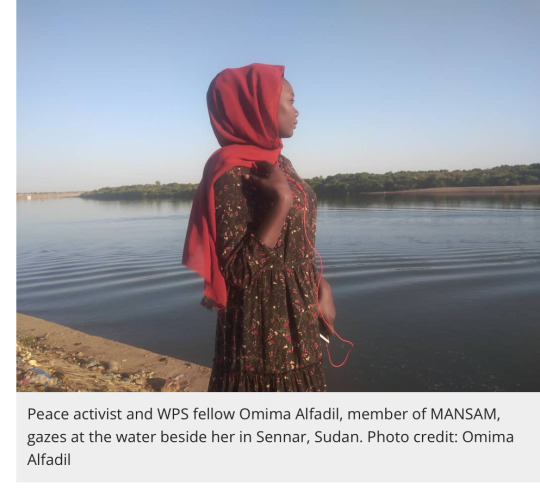
Two years ago, news outlets covered a story of prejudice against women activists from African countries in the climate movement. The Associate Press cropped Vanessa Nakate, a Ugandan climate activist, out of a photo with white activists at a climate conference. In the following days, conversations surrounding racism against activists ensued, with more people coming forward to share their experiences. Apologies were issued and the paper claimed they had no ill intent, but this is a broader recurring theme: the media portrayal of environmental justice is often not inclusive of the people who are most affected by climate change. In response to the situation, Nakate said “You didn’t just erase a photo. You erased a continent.” The silencing of African activists is especially distressing because countries in Africa are among the places most vulnerable to climate change. Climate change exacerbates existing gender inequities by increasing the risk of violence, jeopardizing human security and hindering everyday peacebuilding.
Columbia University’s Women, Peace and Security (WPS) program has worked for the past five years to address these issues, and supports everyday women peacebuilding efforts and climate work by increasing the visibility of grassroots African women activists through fellowships, research and workshops. This winter, the program hosted a global workshop for women activists and scholar-practitioners across 13 countries, marking the culmination of three months of vibrant virtual exchange. The WPS fellowship has supported women peacebuilders in Africa for the past three years by hosting fellowships that create collaborative spaces for sharing everyday peacebuilding strategies, facilitating an intracontinental network of grassroots women peace activists, and publicizing lessons learnt from their experiences.
Women peacebuilders in the fellowship engage in everyday peacework activities, from facilitating sexual and reproductive health and financial literacy programs to resource conflict resolution. This fall, over a number of months, the activists began to organize key messages they have for funders, policy makers and academics aiming to support everyday peacework. They asked themselves and each other what gaps exist, both in terms of knowledge and also myths, that urgently need re-shaping in the fields of policy, practice and funding. Through facilitated small group discussions and virtual exchanges, the women also reflected on their own understanding of peace and security since beginning to work together as a multi-scalar, transnational network three years ago.
In their daily work, these activists interact with funders and policy makers with the resources to aid their mission, giving them direct knowledge on what most urgently needs to shift in the field of peace and security. One key critique was about who was included and excluded in key decision making. Women, youth, queer and disabled people are often missing from critical dialogue, resulting in ineffective policies that are furthered hindered by government bureaucracy. Grassroot women activists play an integral role in maintaining peace and security at all levels of government, as they possess intimate knowledge of their community’s needs and are able to replicate programs on a national scale that influence policy making.
For example, the Hope for the Needy Association (HOFNA) in Cameroon used trainings and capacity building to empower a network of community leaders who are responding to issues of gender-based violence and poverty in their communities. One of the members led an initiative to meet the needs of elderly people and widows in conflict-affected communities. “Everyday peace work in those communities consider the diversity, differences and different perspectives, values, beliefs, and cultures, as these are the elements that make peace work sustainable in the communities,” said Christelle Bay, one of the members of HOFNA
Funding agencies need to engage in conversations with groups like HOFNA, which will allow them to allocate resources appropriately and create a conducive environment for future projects. These women have an expansive view of peace and security that is not limited to the absence of war but includes “access to land, education, health care, infrastructure, equality, equity and social justice,” as stated by Margaret Sedziafa, member of Women International League for Peace and Freedom in Ghana.
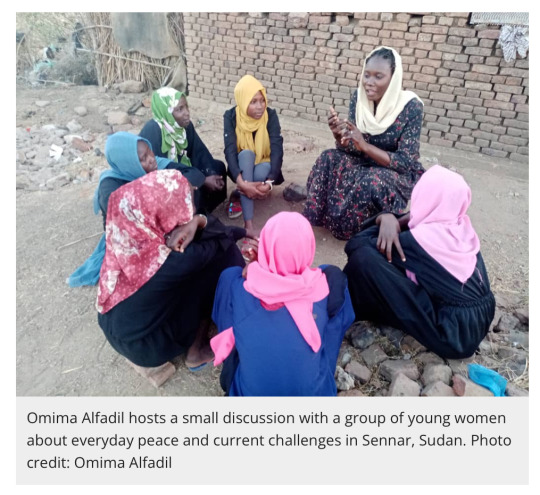
Another core message the group highlighted, however, is that inclusivity is not only necessary in regards to who is seated at the decision making table, but also who is able to tell the stories that influence these decisions. Several women spoke to the importance of being equipped to share their stories themselves, with many chorusing their experiences that Western storytellers often extract “overly emotional or biased accounts” and repeat generalized perspectives without giving space for individual experiences. Over the course of the WPS program, many of the fellows shared how inspired they were to start writing, and documenting their own experiences. At the workshop, several women spoke of the books and creative projects they are working on—inspired by the fellowship and the need to get their voices out in the public sphere. Lineo Matkhala, a Lesotho-based activist working at the Barali Foundation, said, “Let people tell their [own] stories. Get information from both victims and victors. War isn’t just guns and explosives. It exists behind doors, in churches and schools. Do not direct the story, document it.”
The fellows were re-energized by the multiple-month virtual exchanges and final workshop. The messages shared in the virtual exchange are being captured in a co-authored collective paper on transforming the field of women, peace and security and what they have learned in these years as a collective network. They recognize that the contributions of women activists in Africa have been instrumental in toppling oppressive governments, implementing COVID-19 protocols, and serving their communities on a local and national level. Yet, they continue to be silenced in several spaces, from environmental justice to peacebuilding. The fellows restated the importance of funders, policy makers, and academics creating spaces for working together and cross-learning strategies of everyday peace and justice.
Betty Sharon, of Collaboration of Women in Development in Kenya shares the following message to younger women invested in peace and security: “Raise your voices. The more we join our hearts together, the more we join our sisters and raise our voices louder, the stronger we become, the louder our voices become, and that is when we will be heard in all the corners of the world.” This message holds true for activists like Nakate, who are determined to be heard for the benefit of their communities.
#Africa#women#Vanessa Nakate#a Ugandan climate activist#Women Peace and Security (WPS)#columbia university#Hope for the Needy Association (HOFNA)#Women International League for Peace and Freedom in Ghana.#Barali Foundation#Collaboration of Women in Development in Kenya#Lineo Matkhala#A Lesotho-based activist
6 notes
·
View notes